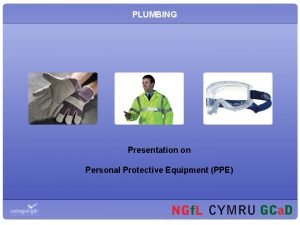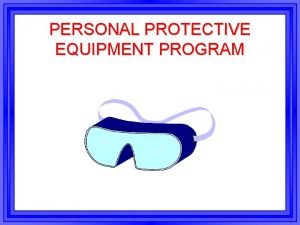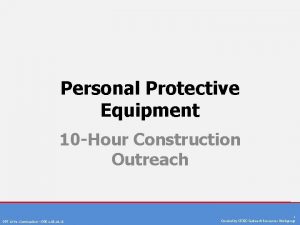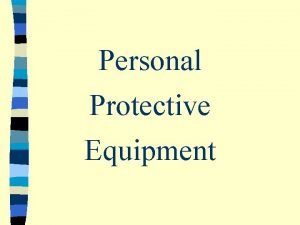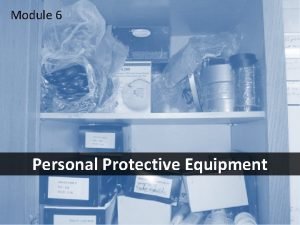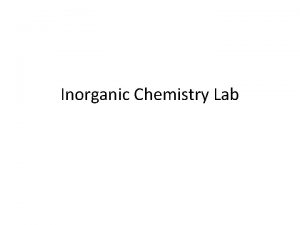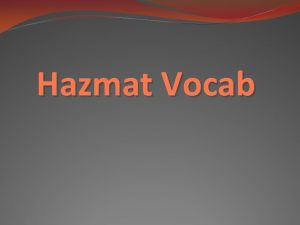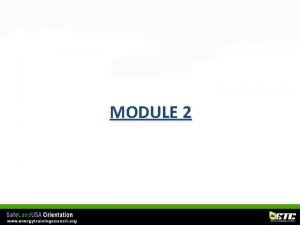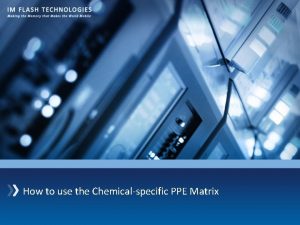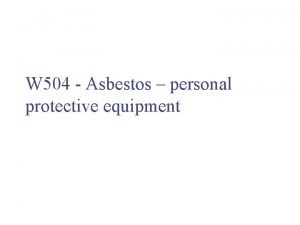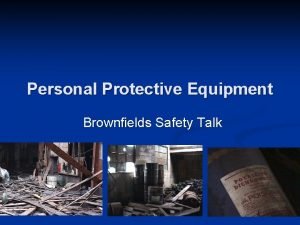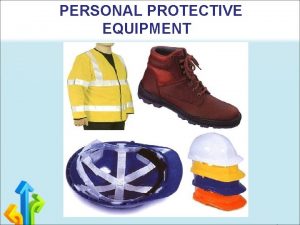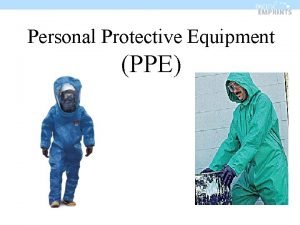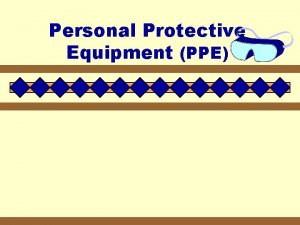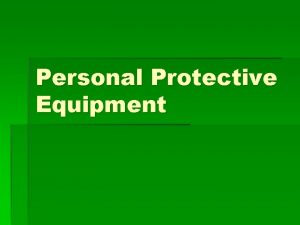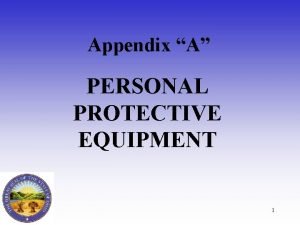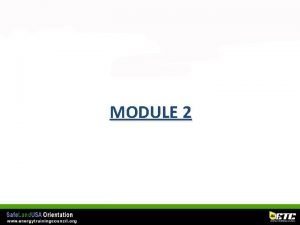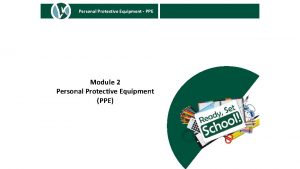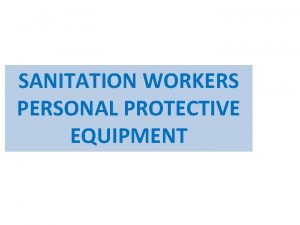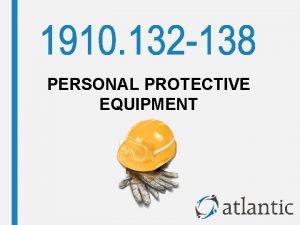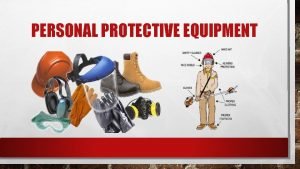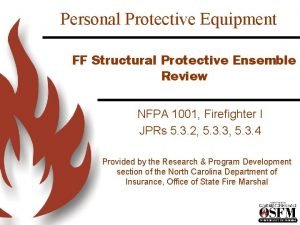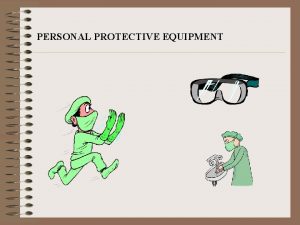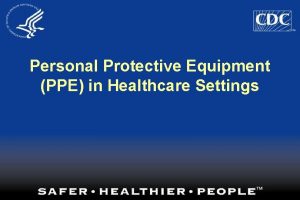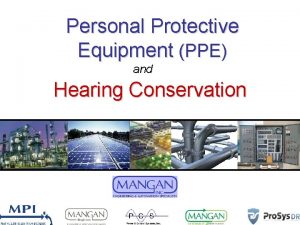Chapter 10 Personal Protective Equipment 2012 Delmar Cengage






















- Slides: 22

Chapter 10 Personal Protective Equipment © 2012 Delmar, Cengage Learning

Personal Protective Equipment • PPE provides an effective means for protecting technicians from hazardous situations • Engineering and environmental controls provide another layer of protection. • The primary purpose of PPE is to prevent exposure to hazards when engineering or environmental controls cannot. © 2012 Delmar, Cengage Learning

Outerwear • • • Safety hats Safety glasses Fire-retardant clothing Safety shoes Hearing protection Gloves Face shield Chemical monogoggles Slicker suit Total encapsulating chemical protective suit © 2012 Delmar, Cengage Learning

Hand Protection • Many of the gloves used by chemical technicians have a wide variety of operational limitations; one type of glove cannot be used for every job. • Glove charts will provide all the information you need to select the right glove. © 2012 Delmar, Cengage Learning

Figure 10 -2 Approved Eyewear © 2012 Delmar, Cengage Learning

Eye Protection • Wear approved eye protection where minimum eye protection is insufficient. • Wear approved face protection where face and eye injury is a concern. © 2012 Delmar, Cengage Learning

Foot Protection • The design composite of the soles must be chemical resistant, puncture proof, slip resistant, abrasion resistant, and provide cushioning support. • Footwear must pass performance tests for impact and compression according to ANSI Z 41. 1 -1967 and meet class 75 requirements for men’s and women’s shoes. © 2012 Delmar, Cengage Learning

Ear Protection • The CPI regulates noise levels over an eight-hour, time weighted average (TWA) work shift to be around 85 d. BA. • Exposure should never exceed 115 d. BA. © 2012 Delmar, Cengage Learning

Hazards in the Workplace • • • Burning Exploding Cutting Electrocution Impaling Tripping Toxic chemicals Chemical burns Asphyxiants © 2012 Delmar, Cengage Learning

Emergency Response • Four levels of PPE, Level A is the highest requiring TECP, Level B deals with chemical exposures that are not considered extremely toxic unless absorbed through the skin, Level C is used when the hazard is determined to not adversely affect human skin, Level D is the minimal amount of protection. © 2012 Delmar, Cengage Learning

Figure 10 -4 Four Levels of PPE © 2012 Delmar, Cengage Learning

Written Respiratory Protection Programs • Fit testing is a procedure that ensures the respirator forms a good seal on the technician’s face. During fit test training the technician learns the following: • • • Which respirator will be used in their area Which respirator fits their face How to properly don a respirator How to select a respirator Specific hazards in their assigned units © 2012 Delmar, Cengage Learning

Air-Purifying Respirator • Designed to remove specific contaminants or organic vapors from the air. • Half-face covers the mouth and nose. • Full-face covers the eyes, mouth, and noise. © 2012 Delmar, Cengage Learning

Air-Supplying Respirators • Designed to be used in oxygen-deficient atmospheres and to provide protection. • Comes in two designs: self-contained breathing apparatus and hose line respirators. © 2012 Delmar, Cengage Learning

Selecting a Respirator • Will the respirator I choose protect me from the environment I will be working in? • The process technician is required to reference the MSDS. © 2012 Delmar, Cengage Learning

Figure 10 -6 Air-Purifying Respirator © 2012 Delmar, Cengage Learning

Caring for and Using Respirators • OSHA inspectors will cite the company for improper storage of a respirator. • SCBA users typically train monthly on donning and using the air-supplying respirator. • When a respirator is used the technician should perform a positive or negative fit test. © 2012 Delmar, Cengage Learning

Figure 10 -7 Full-Mask Air-Supplying © 2012 Delmar, Cengage Learning

• Air-purifying respirators remove contaminants from the atmosphere by putting a filter between the contaminant and the respiratory tract of a technician. • Air is purified through mechanical filtration or chemical absorption. • Air-purifying respirators do not provide oxygen, so the atmosphere’s oxygen content must not be below 19. 5%. © 2012 Delmar, Cengage Learning

Self-Contained Breathing Apparatus • Most SCBA have full-face pieces and weigh between 35 and 45 lbs. • SCBAs provide a self-contained air supply that will last 30 to 60 minutes. © 2012 Delmar, Cengage Learning

Figure 10 -8 SCBA © 2012 Delmar, Cengage Learning

Figure 10 -9 Hose Line Respirator © 2012 Delmar, Cengage Learning
 Chapter 6:2 interpreting word parts
Chapter 6:2 interpreting word parts 2009 delmar cengage learning
2009 delmar cengage learning Clinical conditions chapter 1 medical terminology
Clinical conditions chapter 1 medical terminology Measuring and recording apical pulse
Measuring and recording apical pulse Chapter 6 the skeletal system answer key
Chapter 6 the skeletal system answer key 2009 delmar cengage learning
2009 delmar cengage learning 2009 delmar cengage learning
2009 delmar cengage learning Delmar cengage learning instructor resources
Delmar cengage learning instructor resources Ppe for plumbing
Ppe for plumbing Program
Program Protective equipment in sports ppt
Protective equipment in sports ppt Ppe of smaw
Ppe of smaw Objectives of ppe
Objectives of ppe Personal protective equipment for farmers
Personal protective equipment for farmers 6 personal protective equipment
6 personal protective equipment Personal protective equipment in chemistry laboratory
Personal protective equipment in chemistry laboratory Personal protective equipment vocabulary
Personal protective equipment vocabulary Personal protective equipment summary
Personal protective equipment summary Personal protective equipment pictograms
Personal protective equipment pictograms Ppe matrix for chemical handling
Ppe matrix for chemical handling Asbestos personal protective equipment
Asbestos personal protective equipment Ppe in plumbing
Ppe in plumbing Personal protective equipment safety talk
Personal protective equipment safety talk








